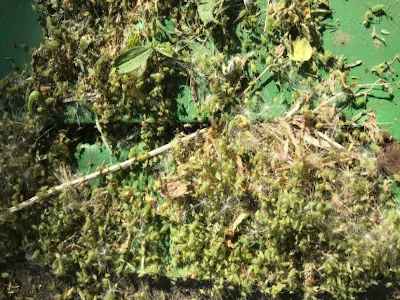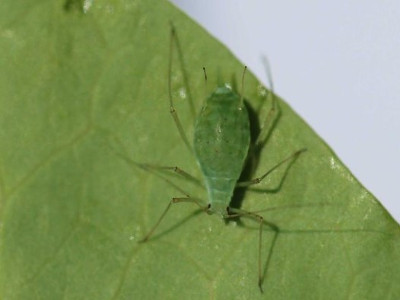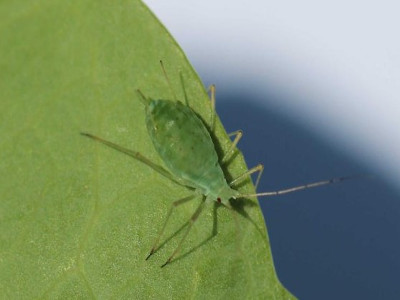By Adam Varenhorst
Although recent temperatures have been above normal, we did experience cool conditions for most of the spring. The cooler conditions slowed the development of many insect pests, but some species thrive in cool conditions. One of those species are pea aphids, which are a pest of many plants, including alfalfa. Recent reports have indicated that pea aphid populations are very large in some alfalfa fields and should continue to be monitored and possibly managed (Figure 1). When pea aphid populations exceed thresholds, yield reductions are possible. There are many natural enemies or predators that are attracted to fields with pea aphid infestations. In alfalfa, these include multiple species of lady beetles, minute pirate bugs, green lacewing larvae, damsel bugs, and hoverfly larvae. These insects can be efficient at managing pea aphid populations. However, during optimal weather conditions (around 70°F) pea aphid populations can increase rapidly making it necessary to manage them using insecticides. With the potential for cooler weather next week, it is possible that the pea aphid populations could continue to grow rapidly.

Figure 1. Large amount of pea aphids and alfalfa weevils on windrower after cutting alfalfa.
Pea Aphid Description
Pea aphid nymphs and adults vary in size, but adults are approximately 1/8 to 1/4 of an inch in length making them noticeably larger than other aphids species present on alfalfa. The nymphs and adults are generally light green-yellow or dark green in color. However, it is possible to observe pea aphids that are a pale pink color. Pea aphids have long cornicles (tailpipes) that are noticeably darker at the tips. A characteristic that is useful for identifying pea aphids is the dark bands present on their antennae (Figure 2). Pea aphids also have red eyes that can be useful for identification purposes (Figure 3). They tend to colonize alfalfa throughout the entire season, but their population growth is reduced when temperatures exceed 90°F.
Pea aphid colonies tend to occur on alfalfa stems and the newest leaves. When large populations are present on a plant the leaves of the alfalfa may turn yellow, and the plant may also be stunted due to the nutrient loss caused by pea aphid feeding. This type of injury is generally associated with populations of pea aphids that exceed 50 aphids per stem, which would be a very noticeable infestation.

Figure 2. Pea aphid top view. Notice the dark tips on the “tail pipes.”
Pea Aphid Scouting and Management Guidelines
Generally, pea aphid populations are not much of a problem, though it is common to see some population growth after the application of insecticides if aphids were not present at spraying. This occurs because insecticide sprays remove natural enemies that may be keeping pea populations low. In addition, reports of pyrethroid insecticide failures for pea aphid management have occurred in South Dakota. To stay ahead of pea aphid populations, alfalfa should be scouted on a weekly basis throughout the season to ensure that populations do not exceed the recommended thresholds (Table 1). To scout for pea aphids in alfalfa, either a sweep net or direct stem counts can be used.

Figure 3. Pea aphid side view. Notice the red eyes.
If using a sweep net to sample, conduct 30 pendulum swings for each leg of a “W” or “Z” pattern while walking in the field. Count the number of each species present after every 30 swings and calculate averages. Repeat this process in an additional area of the field to determine field infestation levels.
If using the direct stem counts collect a total of thirty stems while also walking in a “W” or “Z” pattern. For each stem carefully cut it near the soil surface, and shake it into a white bucket, then count the total number of aphids per stem and calculate an average for the field.
No matter which method you use, while walking through the field pay attention to the presence and abundance of natural enemy species. If numerous natural enemies are also collected in the sweep net or observed while walking, insecticide management may not be necessary depending on the aphid populations and daily average air temperatures. However, if thresholds are exceeded a list of insecticides that are currently labeled for aphid management in alfalfa can be found in the latest South Dakota Pest Management Guide: Alfalfa and Oilseeds.
TABLE 1. ECONOMIC THRESHOLDS FOR AVERAGE PEA APHIDS IN ALFALFA PER 30 SWEEPS OR 30 STEMS.
| | Average Number of Pea Aphids Found |
|---|
| Growth Stage | Sweep | Stem |
| Seedling | -- | 5 |
| Less than 10” tall | 300 | 40 |
| More than 10” tall | 400 | 75 |
Source : sdstate.edu